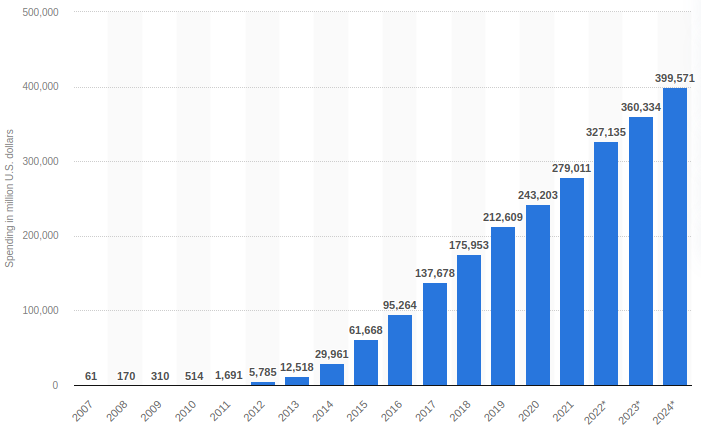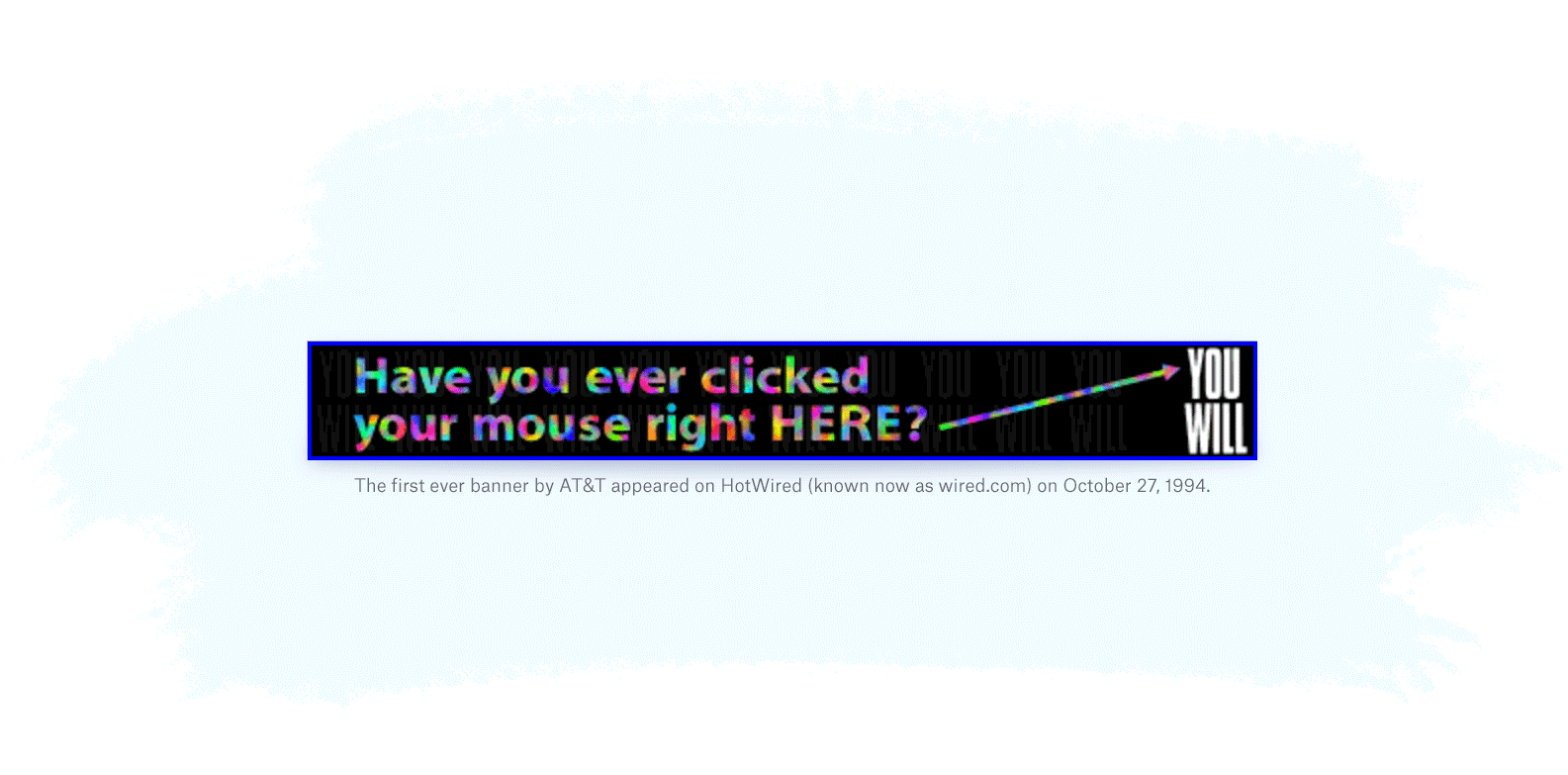The concept of advertising dates back to the early periods of human history when people were first starting to flirt with the idea of specialization of trade. Merchants used signs & symbols to advertise their goods and ancient Egyptians used papyrus to make sales posters. The concept and purpose of advertising has stayed relatively the same over the centuries, but the medium has dramatically changed.
At the Open Ads Protocol, we like to think deeply about the more recent history of marketing: digital advertising. In the past 20 years, we have seen a revolution in the advertising industry like no other. In order to understand where the industry is headed, it’s important to take a step back and appreciate how far we’ve come and learn from prior pitfalls to help illuminate the path ahead.
Our team believes that the future of advertising is a transparent model that focuses on the customers first. Let’s rewind the tape and stroll through the evolution of digital advertising.
Pre-Google era (1994 - 1999)

The first chapter starts in 1994 when there were an estimated 30 million people online worldwide. HotWired, the web version of the beloved Wired magazine, displayed this ad for AT&T, with a message “Have you ever clicked your mouse right here? You will”.
A new industry was born.
With the success of AT&T's banner ad, advertisers sought ways to better target their ads. WebConnect, the first ad network, emerged in 1995 to help advertisers identify websites their ideal consumers frequented, thus placing ads where they were most likely to be seen by the relevant audience.
The increase in online display ads led to the need for measuring ad performance. In 1996, DoubleClick, one of the world's first ad servers was introduced, enabling advertisers to track their ad's performance and better target internet users. DoubleClick also brought about ROI tools for ad campaigns, allowing businesses to evaluate the effectiveness of their advertising spend, a major step in the growth of the industry.
Then, some guy invented pop-up ads in 1997, making online ads go from mildly intrusive to universally hated.

I could have picked a much more obnoxious example. Due to their intrusive nature, pop-up ad blockers were quickly developed, reducing their effectiveness very quickly.
As the web expanded rapidly, search engines emerged to help users navigate the vast amount of information online. 1998 saw the introduction of paid search and Pay-Per-Click (PPC) advertising by GoTo.com. Google was founded this year and in a couple of years their market share and innovative ad units would change the game.
We should note, though, pioneers like G.M. O'Connell and his venture Modem Media were among the first to navigate the uncharted waters of digital advertising as early as 1987. Their foray through the late 90s, though embryonic, set the framework for the digital advertising landscape we are familiar with today.
Google / Facebook Era (2000 - 2010)
As the calendar flipped to 2000, Google unveiled AdWords, planting a milestone in the digital advertising timeline. Their version of the Pay-Per-Click model and the ability to bid on individual keywords made advertising both affordable and measurable. For instance, small businesses could now set a budget cap and only pay when someone clicked on their ad.
Now, down we go into the rabbit hole of context based ads, a targeted advertising approach that displays ads to users based on the content they are currently engaging with online. They aim to deliver ads that are contextually relevant to the webpage or content, increasing the likelihood of capturing the user's interest and engagement.
By tracking a user's online behavior, such as the websites they visit, the content they interact with, and their search queries, ad networks were now able build a profile of the user's interests and preferences.
The plot thickened post-2007 when Facebook joined the advertising bandwagon. With a treasure trove of social data, Facebook ads offered a level of personalization that was unmatched. The ability to target ads based on user demographics and interests was a game-changer. For instance, a local pizzeria could target ads to pizza lovers within a specific zip code, or political parties could tailor a message about their candidate depending on a user's political preference.
Through the rest of the decade more and more people came online. These methods of giving people an ad they were most likely to engage with based upon troves of data was continually being refined. The end result being the incumbent, Google, and the up and comer, Facebook, poised to take advantage of the next billion people coming online.
Mobile Ads (2010 - Present):
The narrative takes a mobile turn post-2010 after the iPhone's launch a couple of years earlier.
The launch of app stores, particularly Apple's App Store in 2008, created a thriving ecosystem for mobile apps. This presented a new advertising channel as developers sought ways to monetize their apps. Advertisers started placing ads within mobile apps, including banners, interstitials, and rewarded video ads, creating a billion dollar industry by 2011.

The period from 2008 to 2014 was transformative for mobile advertising, as it evolved from early experiments to a mature and essential component of digital advertising. Advertisers increasingly recognized the potential of mobile devices to reach consumers in personalized and contextually relevant ways.
Simultaneously, the mobile gaming arena bloomed, creating a vibrant canvas for advertisers. Games like Angry Birds and Candy Crush became not just a source of entertainment but a platform for ads. The fusion of gaming and advertising delivered a unique blend, making ad experiences less intrusive and more enjoyable.
Ad-tech really started to hit its stride as mobile Free-to-Play (F2P) games adopted in-app purchases and rewarded advertising as its main form of monetization. Facebook, Applovin, IronSource and others refined their business models as free games battled for top positions in app store rankings fueled by in-app advertising.
However, the proliferation of mobile ads 2014 onward brought along a cloud of privacy concerns as the decade continued. The discomfort over personal data collection by big tech companies for targeted advertising fueled debates as issues like the Cambridge Analytica data collection scandal emerged. If you don't know, they used Facebook data to influence political outcomes in 2015-2018. This era threw spotlight on the delicate balance between personalized advertising and privacy, a dialogue that continues to shape the contours of digital advertising.
Platforms like Snapchat and Twitter also entered the arena around this time both using a similar data collection and monetization model to drive revenue on their products. On top of Google, Apple's, and Amazon's product offerings, the mobile consumer was opted-in to an internet with great free products at the cost of their privacy.
The ad tech landscape has been pretty stagnant since 2018 with few notable industry movements. The exception is Apple's decision to stop sharing iPhone users data externally, causing industry giants Facebook and Google to take a hit to their ad targeting capability. This is viewed by some as more akin to a game of chess than consumer-first thinking as Apple is ramping up its own ad targeting capabilities on the iPhone.
What's next?
Advertising has always been at the forefront of technology: adapting to use the latest and greatest tech that might help advertisers and publishers achieve their goals.
Today, AI & blockchain tech are currently the elephants in the room. At OAP, we’re actively thinking about how innovations in these verticals will change the advertising landscape in the coming decade.
Our team believes that the most crucial lesson we’ve learned from the big tech era of advertising is that the model needs to be transparent, secure, & user oriented.
Enhanced personalization with robust privacy measures, the development of decentralized ad networks, and transparent and efficient real-time bidding systems are all real world use cases that we see as being the future.
If you enjoyed this post or are actively thinking about the future of advertising, make sure to subscribe and follow our journey at OAP. We’re excited to play an active part in the next logical era of this industry - an open ads network. Follow along here or @OpenAdsProtocol on X and @oap on Farcaster.


